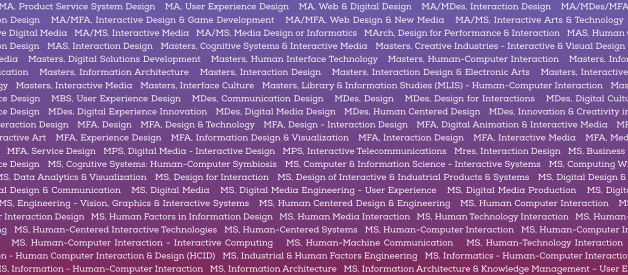Adam Dunford, inUse Experience, Gothenburg, Sweden
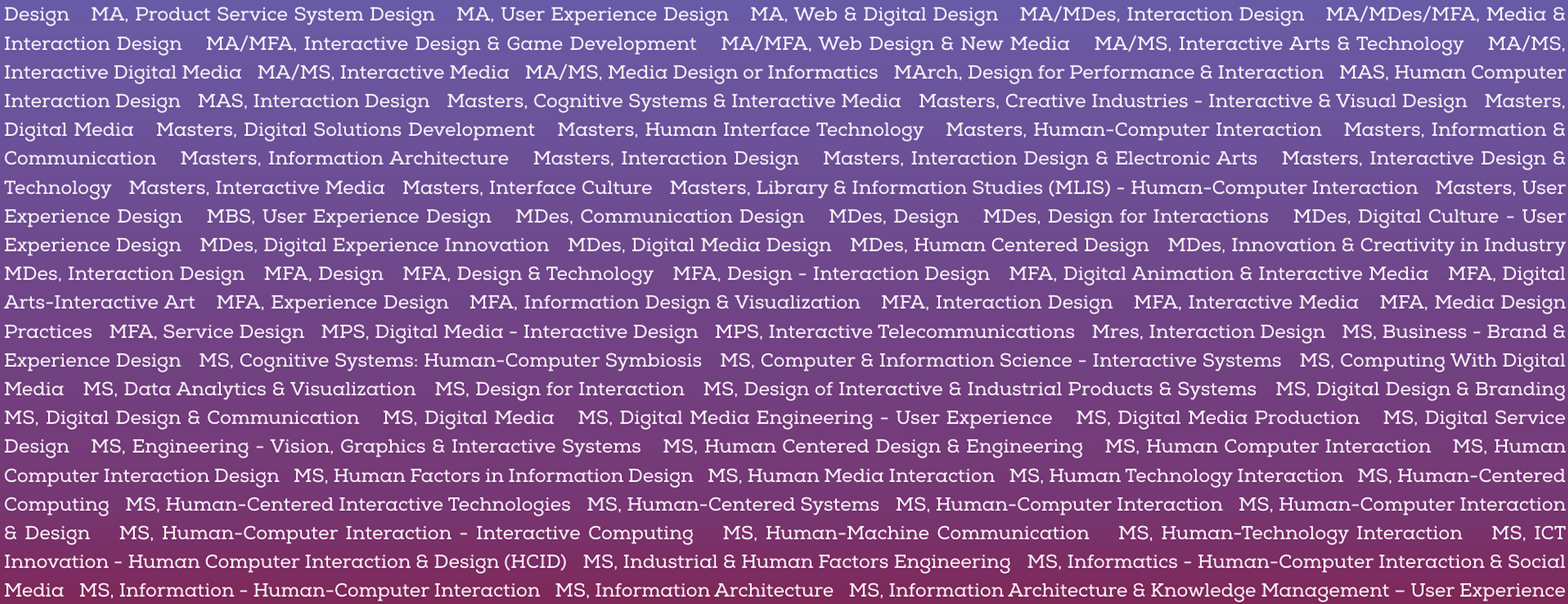
The following is a summary of my talk from IxDA?s Interaction Design Education Summit 18. The talk, in turn, highlights some of the major findings from my master?s thesis in interaction design from Chalmers University.
?All you Scandinavian schools are too focused on products and not enough on process!?
I had returned to school to get a master?s degree in interaction design and was co-presenting a project at a student design conference. After our presentation, a professor at another school complained about our presentation. She said it was too polished and didn?t focus enough on our methodology. From my years of being ?in the industry,? I had gotten used to the idea that results were what counted. Was I not learning what I ought to from my time in school?
Yes, learning is different than doing, industry is not academia. Still, could it really be that business needs actively conflicted with the goals of higher education? Or had my own experiences biased me away from the process-focused outcomes my school was trying to teach?
For my master?s thesis, I researched this gap between interaction design business and education. I examined different design programs and compared them to the job market. I wanted to identify an ideal curriculum that would best fit what businesses truly need.
I was mistaken. There?s no such thing as an interaction design degree.
Before describing how to improve the current state of affairs, it?s helpful to explain how we got here. The main challenges to identifying a core interaction design degree are:
- No common definitions for core concepts. People can?t even agree on what ?interaction design? means or what study areas it encompasses.
- No common curriculum or standards. Educators have failed to organize a shared set of core learning areas or classes, despite repeated efforts. Even informal efforts to share lesson plans and teaching methods suffer from neglect and disuse.
- Different course origins & schools. As a discipline, Interaction design emerged from ergonomics, psychology, information systems, and others. These source origins continue to influence how or what is taught in their interaction design programs.
- Disagreements about the role of education. Instructors also disagree whether schools should focus more on developing specific skills or on cultivating competent thinkers and contributors.
- Institutional requirements & constraints. Instructors must teach core topics, introduce new technology, and develop and nurture students. They must do this in a few short weeks per class. And that?s while they follow curricula requirements that are often years out of date.
- Conflicting demands from industry. Businesses are no better. They ask for graduates who can contribute on day one in a variety of different tools or skills. Yet they don?t devote time to curriculum assessments, student portfolio reviews or other help to academia.
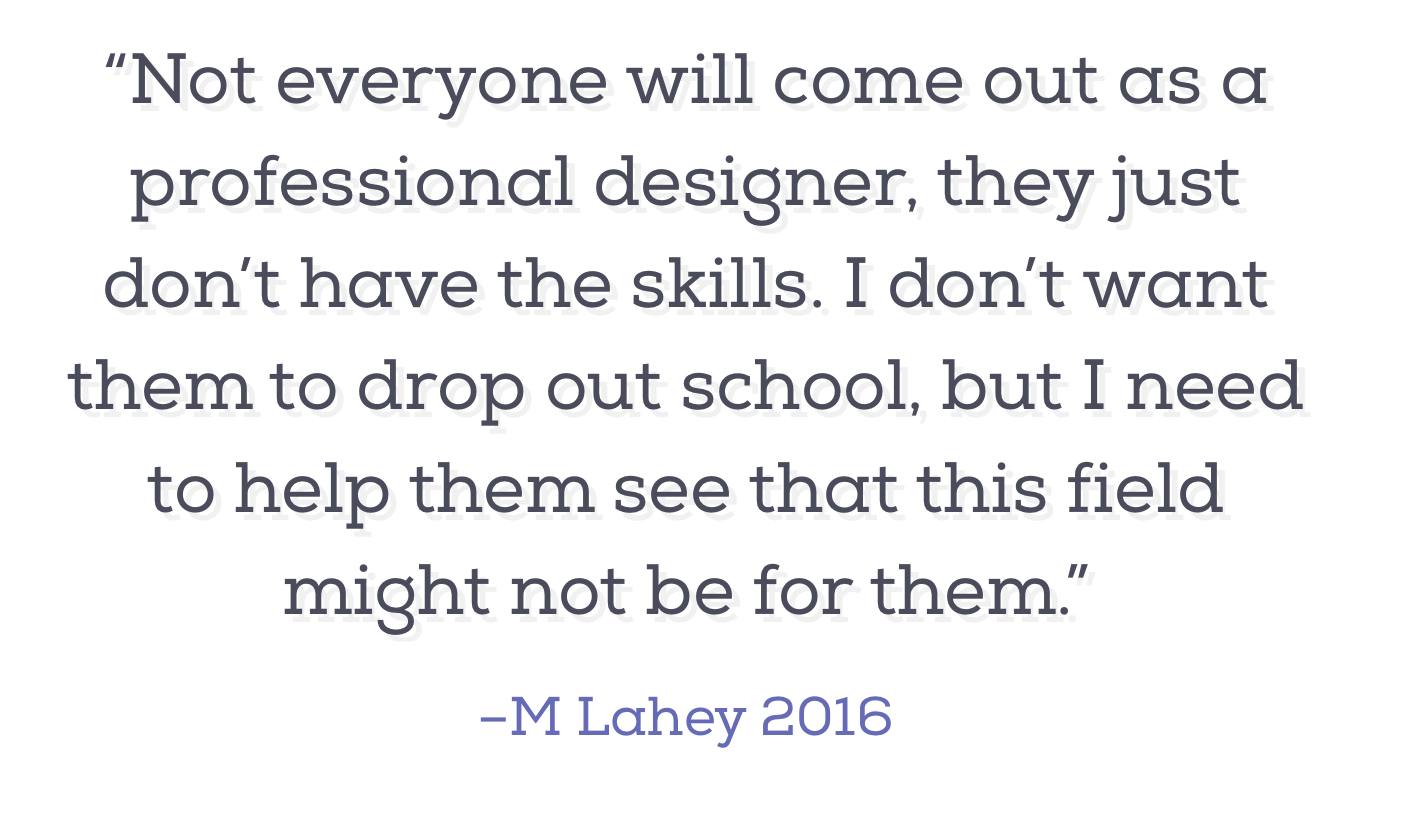
How Are Design Degrees Different?
These factors result in a bewildering variety of schools, programs and curricula for interaction design. How much variety?
For starters, among the 176 different masters-level programs I researched, fully 130 of them had unique titles. Removing the type of degree (i.e. MS, MA, MFA, etc.) only reduced the number down to 108 unique titles. (My favorite? probably the Masters of Science in Information Architecture & Knowledge Management, User Experience Design from Kent State University.)
To make any worthwhile comparison, I needed to refine the degrees further. Degrees with similar titles, like ?Human-Centered Computing?, ?Human Centered Design & Engineering? and ?Human-Centered Systems?, could merge under a shared title, like ?Human-Centered Design.? And it was in this final refinement that 18 title archetypes emerged, each clustered around a uniquely identifiable label.
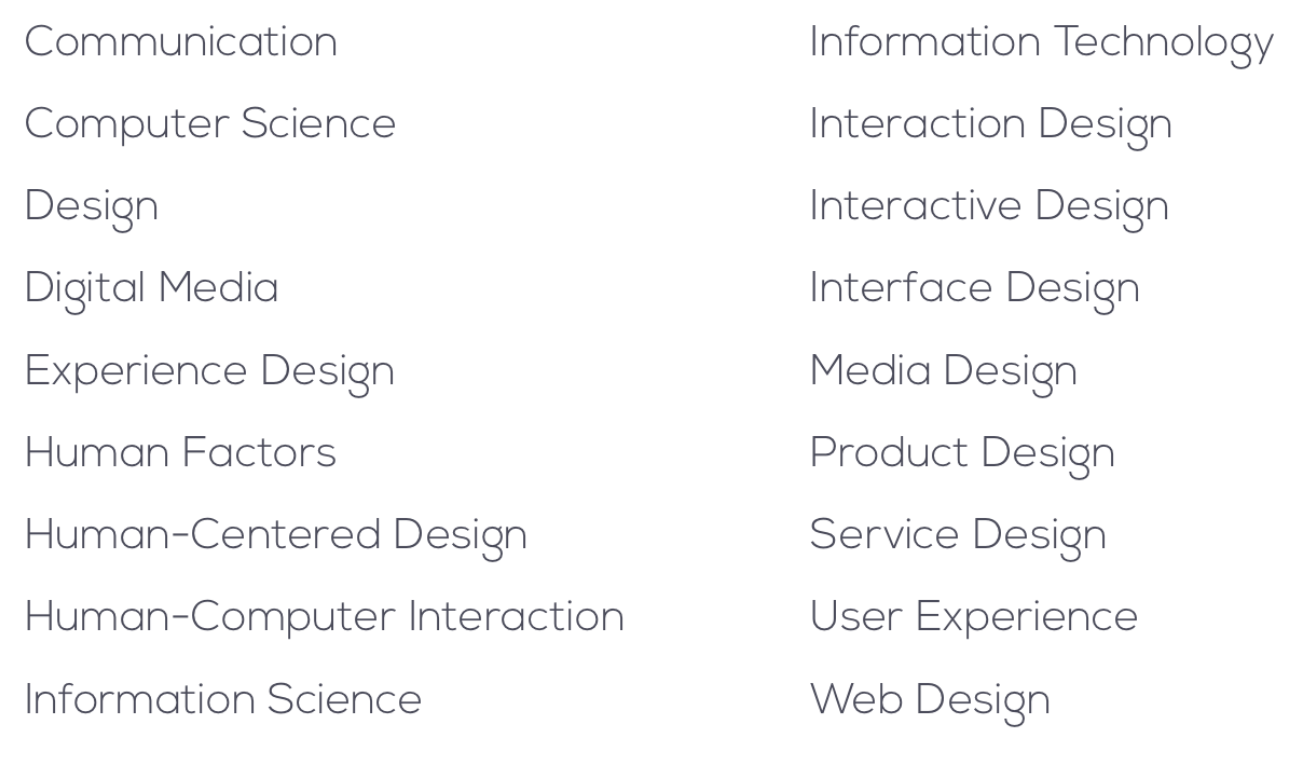
With this breakdown, I could compare these degree types to the countries they were found in, the schools that taught them, and more. I was getting somewhere! Except?I wasn?t. Turns out, there isn?t much of a relationship between the name of the degree and its location. ?Interaction design? is slightly more popular in Europe, while ?human-computer interaction? wins in North America. Nor did the degree title change depending on what kind of school taught the program. Even comparing departments failed to show much of a correlation either. Sure, Computer Science and Information Science departments were more likely to house a Human-Computer Interaction degree, while a Design department housed an Interaction Design degree occupied, but beyond that, there really wasn?t much to learn.
I knew there had to be something more.
How Are Interaction Design Programs Different?
So I took 24 randomly selected, geographically distributed degrees named ?interaction design? and looked deeper. I examined prerequisites, length, coursework, and whether they required a thesis for graduation.
Again, I found more differences than similarities. Only a slight majority were two years long, with the rest between one year and three years long. Nearly all requested a bachelor?s degree and transcripts, while less than half required a rsum or an interview. For final projects, it was pretty evenly split between those that used a thesis and those that used a capstone project. Interestingly, four programs didn?t require either.

I tallied all the individual courses they taught and found 391 unique course titles. As with the program names, I optimized the names further, such as consolidating all the ?prototyping? classes together. I found 49 different required courses, and not one of them appeared in even 50 percent of the other programs. That?s right, none.

Indeed, there is no such thing as an interaction design degree.
Why Does This Matter?
Without consistent degree names and programs, prospective students can?t accurately compare schools. They choose programs based on proximity or reputation, not on specific skills they hope to gain or specialties they hope to pursue.
Employers similarly don?t have a sense for what skills, knowledge or ability a particular degree might represent on a rsum. They cast a wide net in job listings instead ? like an interaction designer job that required a bachelor?s degree in ?CS, web dev, HCI, mobile computing, graphic design, software engineering or a related field of study.?
Even worse, employers begin to ignore degrees entirely. From the aforementioned survey of interaction designer job listings, 40% did not ask for any degree. They asked for other qualifications or experience instead, something new graduates don?t have.
Without a degree to rely on, employers instead turn to portfolios to assess candidates. The directors and hiring managers I spoke with all said they use the portfolio as the first step in screening potential hires. They consider degree information afterward, if at all. Yet they all also admitted it isn?t a great predictor for an employee?s long-term success. In fact, two design managers said they had recently dismissed employees who had great portfolios. After a few months working, they weren?t showing the kind of strategic thinking needed to solve problems for their clients. Even with that direct experience, the managers admitted they were still using portfolios to evaluate replacements. School degrees remained unimportant.
How Do We Solve This Problem?
Looking at these effects, it?s clear we need something better. A few possible solutions emerge.
- Standardize degree titles across schools. Having a unique title seems less about describing a degree and more about marketing or vanity.
- Create an accrediting body for IxD. Practice the oversight of other education disciplines and establish standards and reviews. Maybe something that IxDA or Cumulus can provide?
- Start a website of programs, classes, etc. Create (yet another) directory of interaction design programs, including information about prerequisites and curricula.
- Establish IxD certifications or licensure. Follow fields like law or medicine and require extra training and testing before being licensed to practice.
- Do nothing. After all, graduates are getting jobs, aren?t they?
- Create an IxD competency framework. Map the skills needed to be a successful interaction designer.
These all have varying degrees of difficulty and likelihood of success (yes, even #5). For my thesis, I chose to consider that last option.
The Interaction Design Competency Framework
A competency refers to how well a person uses their various skills, knowledge & attitudes to accomplish specific tasks or objectives. Competency models already exist for other industries, but none for interaction design.
From the school and job research I performed and interviews I conducted, I found 286 competencies for interaction designers. These range from technical skills to design methods to applications, even personality traits.
By grouping these competencies into common areas, a pattern emerged (finally!). The Interaction Design Competency Framework is the result of this organization. As conceived, the framework:
- Presents a job?s task and work areas at a glance
- Facilitates comparisons between different jobs or degrees
- Allows for deeper exploration of skill areas
- Flexibly accommodates new competencies so that it can remain relevant
Instead of prescribing a particular set of competencies to fit all roles, the framework sorts these competencies into domains and facets:

Domains of Competency
- Design ? Graphics, Interfaces, Interactions
- Computing ? Programming, Functionality, Performance
- Research ? Observing, Interpreting, Evaluating
- Business ? Managing, Planning, Marketing
- People ? Communicating, Empathizing, Motivating
Facets of Competency
- Knowledge ? what you must know to perform a task
- Skills ? how you perform a task
- Attitudes ? how you feel as you perform a task
- Tools ? what you use to perform a task
- Qualifications ? what indicates you can perform a task
Using this framework, one can then take a given job listing, extract all the competencies and then organize them into their appropriate domain facets.
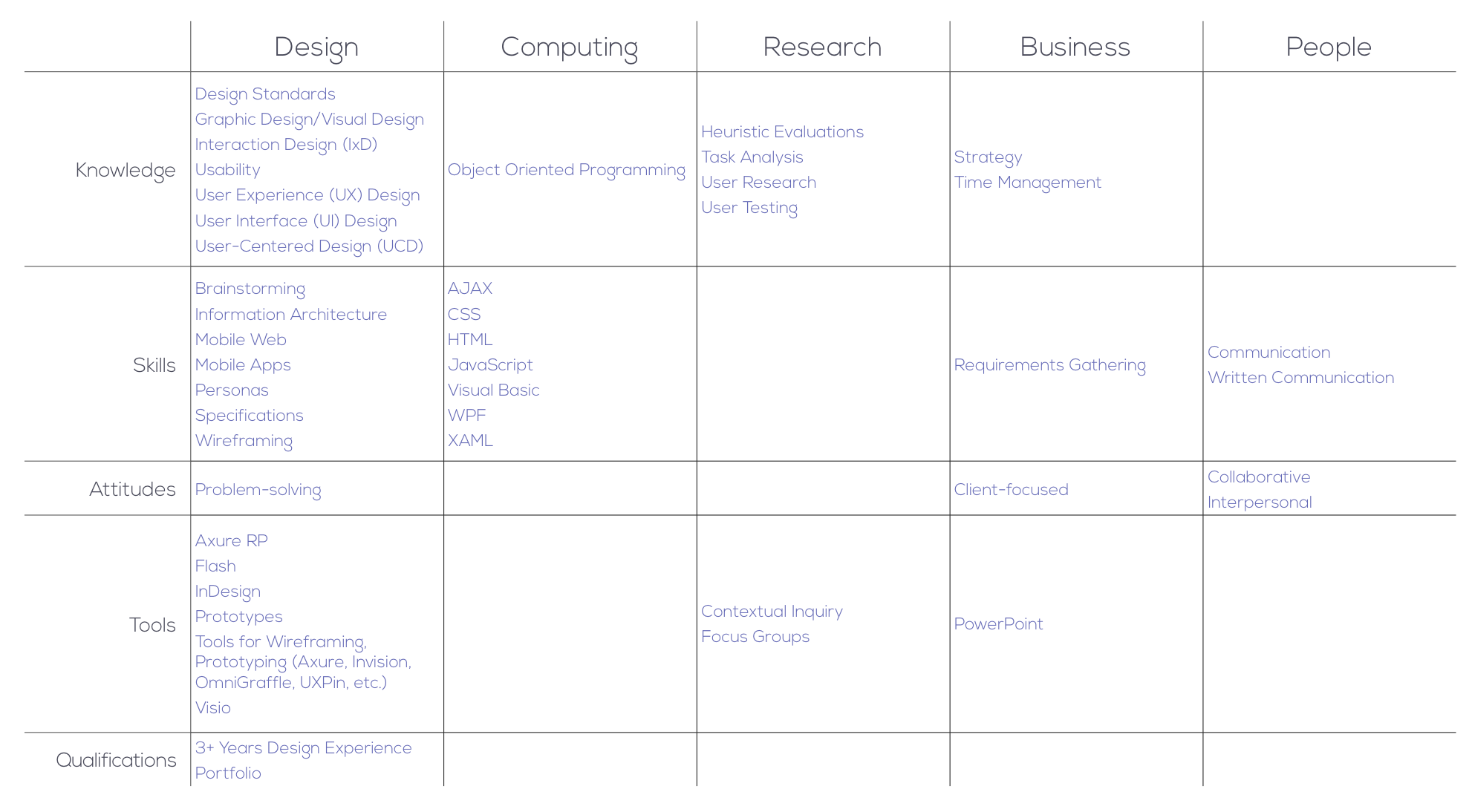
By then calculating competency distribution, one can then compare job listings (or schools or even designers themselves) and see what is most relevant. For example, apply the framework to two different jobs, both asking for an ?interaction designer.? We can see at a glance that the first (left)wants more business and people competency while the other (right) is looking for more pure design, with some research.

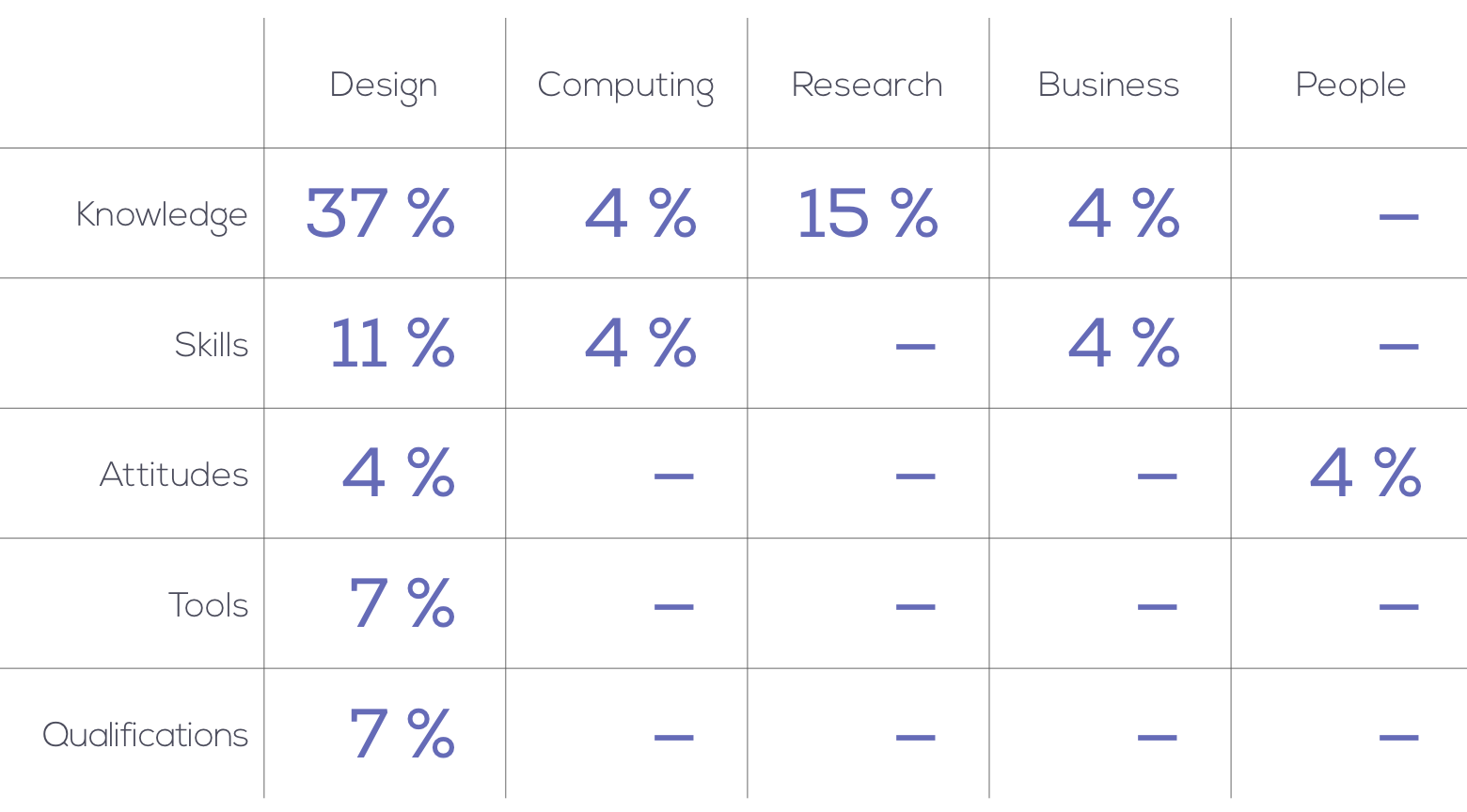
What?s next?
As with all ideas, this one needs some refinement. From my comparative research of 24 interaction design job listings, certain domain facets appear more often, such as Design Knowledge. Now this could be because those competency areas are the most important. Yet just because a competency is included in a job description, that doesn?t mean it?s frequently needed on the job. And just because a competency area isn?t listed, it doesn?t mean that it?s not important. (As bad as degree program listings are, job listings are even worse.)
Yet it is a first step.
Indeed, we don?t just need interaction design degrees. We need better ways to understand them.
I welcome all feedback! For more details, download my thesis.
For more visuals, check out my full slide deck:
 Sketchnotes by Ashish Goel
Sketchnotes by Ashish Goel
About Adam
I?m a UX designer and information architect by trade, a project manager and director by experience, and a teacher by mentality. Indeed, my most fulfilling results have come only after a client comprehends why a design decision has been made and a user learns how to interact with a product or service to accomplish their goals.
After moving to Sweden a few years ago to get a master?s degree in interaction design, I currently work alongside excellent colleagues at inUse, bringing ethical, thoughtful, and innovative service and interaction design to clients in healthcare, automotive, government, and technology.
